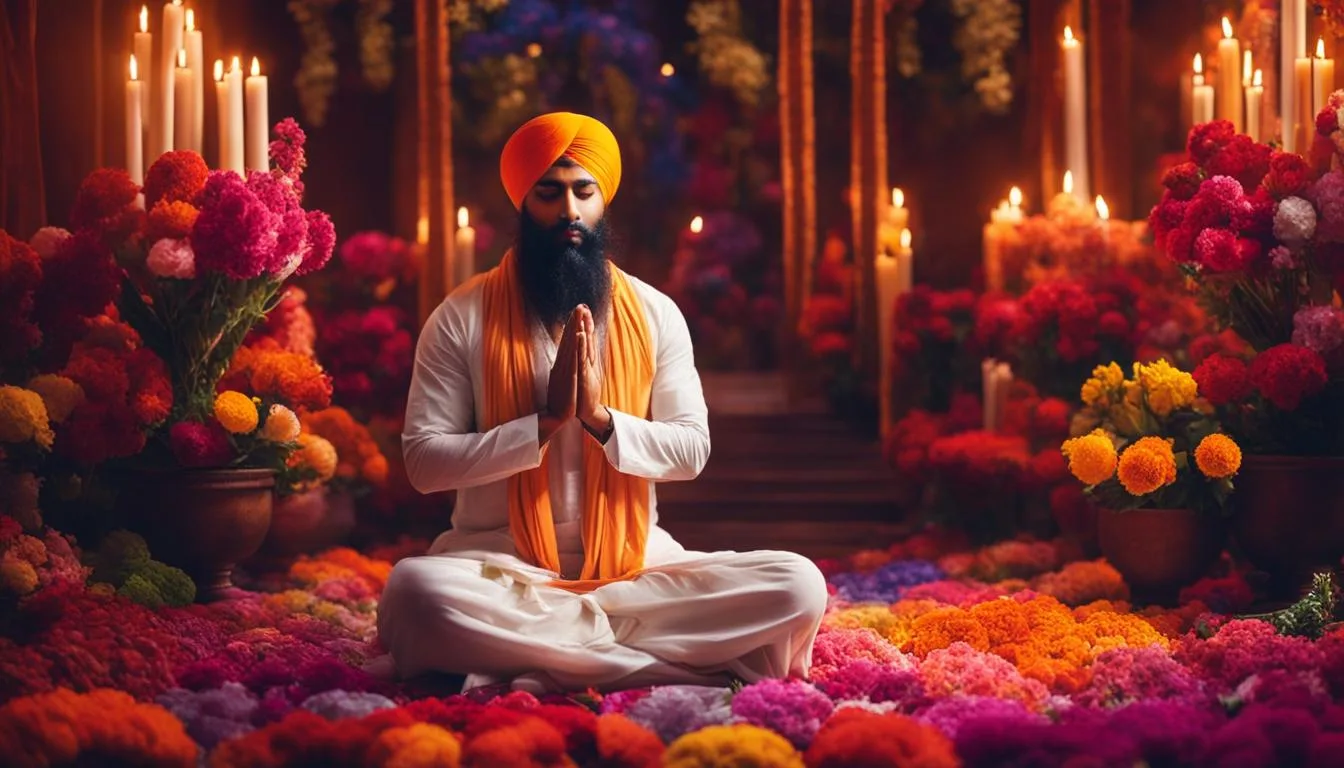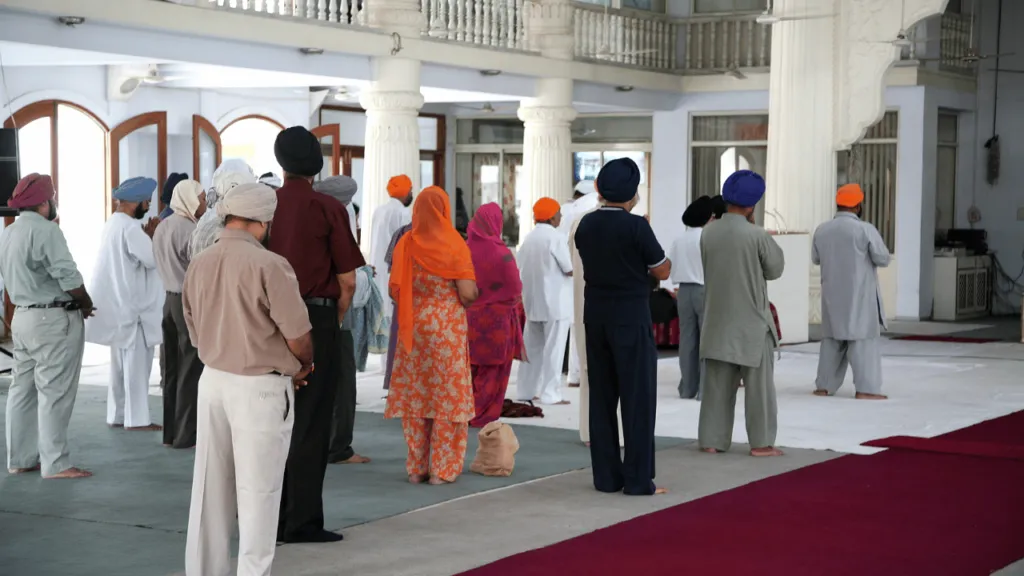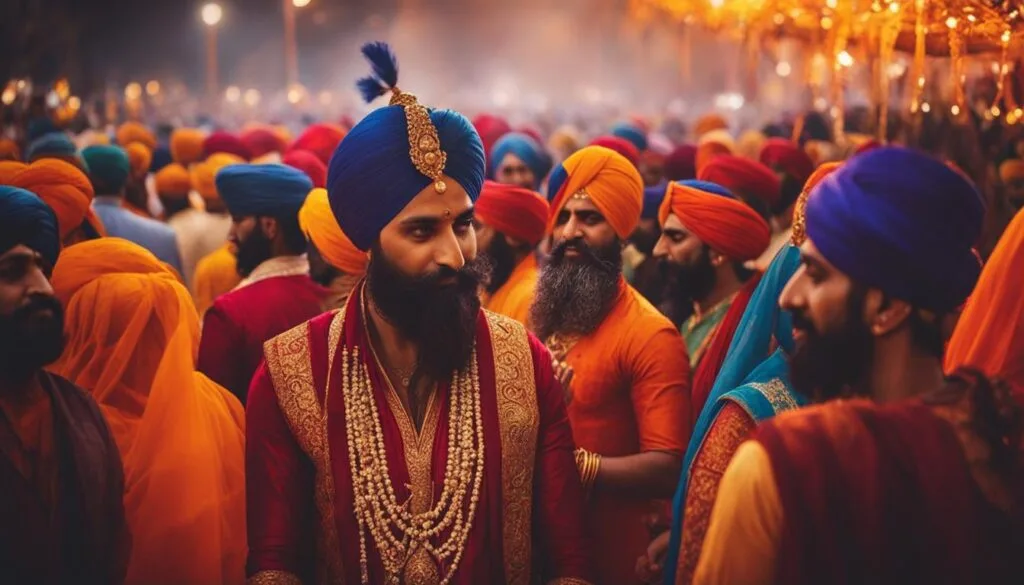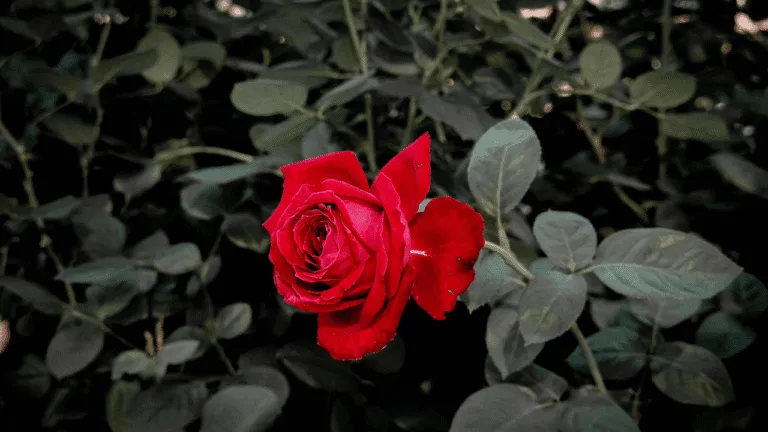Sikh Prayer Customs The Soulful Chants Unveiling Sikh Prayer Customs

Sikh prayer customs are an integral part of the Sikh faith. Sikhs engage in various rituals and practices to connect with the divine and find spiritual fulfillment. These customs include attending gurdwaras, bowing before the sacred scripture, singing hymns, and reciting the Ardas prayer. These practices create a sacred and meditative atmosphere for Sikhs to express their devotion and seek spiritual guidance.
Key Takeaways:
- Sikh prayer customs are an integral part of the Sikh faith.
- Sikhs engage in various rituals and practices to connect with the divine.
- Attending gurdwaras, singing hymns, and reciting prayers are key components of Sikh prayer customs.
- These customs create a sacred and meditative atmosphere for Sikhs to express their devotion.
- Sikh prayer customs help Sikhs seek spiritual guidance and find fulfillment.
The Importance of Gurdwaras in Sikh Prayer Customs
Gurdwaras hold great significance in Sikh prayer customs. They serve as both the house of worship and a place for communal gathering. The Adi Granth, the sacred scripture of Sikhism, is present in every gurdwara, and attending Sikhs must enter with their heads covered and feet bare as a sign of reverence.
Sikh worship in gurdwaras primarily consists of singing hymns from the scripture, fostering a deep connection with the divine. Every service concludes with the recitation of the Ardas prayer, a collective supplication for guidance and blessings. The distribution of karah prasad, a sacramental food made from whole wheat flour, ghee, and sugar, serves as a final act of devotion and unity among the congregation.
Gurdwaras provide a serene and spiritual environment where Sikhs can come together to express their reverence, seek solace, and foster a sense of community. These sacred spaces embody the core values of Sikhism, promoting equality, compassion, and service to others.
The Denouncement of Caste in Sikh Prayer Customs
Sikh prayer customs reflect a strong rejection of the caste system. The Gurus denounced caste as irrelevant to spiritual liberation, emphasizing equality and unity among all individuals. This denouncement is clearly visible in the langar, the communal refectory present in gurdwaras.
In the langar, people of all castes sit together in a straight line, breaking down the barriers of hierarchy and discrimination. This egalitarian practice emphasizes the Sikh belief that all human beings are equal in the eyes of the divine, regardless of their social status or caste.
“The rich and the poor, the saint and the sinner, the king and the pauper, all sit round one fire and eat together in the Guru’s kitchen. This has made them all equal.”
This quote by Bhai Gurdas, a prominent Sikh scholar, beautifully encapsulates the essence of langar. It serves as a powerful symbol of unity, where caste differences are completely disregarded, and individuals come together as equals to partake in a communal meal.
Another aspect of Sikh prayer customs that rejects caste-based discrimination is the distribution of karah prasad. Karah prasad, a sacred sweet pudding, is prepared or donated by people of all castes, reinforcing the notion that caste distinctions hold no significance in the eyes of the Guru.
Sikh Prayer Customs and the Denouncement of Caste
| Sikh Prayer Custom | Denouncement of Caste |
|---|---|
| Langar | People of all castes sit together, emphasizing equality and unity. |
| Karah Prasad | Prepared or donated by people of all castes, rejecting caste-based discrimination. |
Through these practices, Sikhism boldly challenges the rigid caste system that has plagued society for centuries. By denouncing caste and promoting equality, Sikhs strive to create a world where every individual is valued based on their character and actions, rather than their social status or birth.
Rites and Festivals in Sikh Prayer Customs
Sikh prayer customs encompass various rites and festivals that hold significant spiritual and cultural importance for Sikhs. These rituals, guided by the Sikh Rahit Marayada, mark important milestones in the lives of individuals and the Sikh community as a whole.
Rites of Passage
The Sikh Rahit Marayada highlights four essential rituals that qualify as rites of passage:
- Birth and Naming Ceremony: A joyous occasion where the newborn child is introduced to the Sikh community. The Guru Granth Sahib is revered, and the child is given a spiritual name.
- Anand Karaj (Marriage Ceremony): A sacred union between two Sikhs, symbolizing the spiritual and emotional bond of marriage. The ceremony takes place in the presence of the Guru Granth Sahib and witnesses.
- Amrit Sanskar: The initiation into the Khalsa, representing a commitment to a life of devotion and following the Sikh Code of Conduct. Amrit, a sweetened water prepared with iron utensils, is blessed during the Amrit Sanchar ceremony.
- Funeral Ceremony: A ceremony to bid farewell to a departed soul and offer prayers for their spiritual journey. The body is cremated, and prayers are recited to honor the deceased.
These rites of passage play a vital role in shaping Sikh identity and fostering spiritual growth within the community.
Sikh Festivals
Sikhism celebrates various festivals that commemorate important events and teachings of the Gurus. Some of the major Sikh festivals include:
- Gurpurabs: These festivals honor the birth or martyrdom anniversaries of the Gurus. Sikhs gather in gurdwaras to sing hymns, listen to sermons, and participate in processions.
- Installation of the Guru Granth Sahib: Celebrated with great fervor, this festival marks the formal installation of the Guru Granth Sahib as the eternal spiritual Guru of the Sikhs.
- Baisakhi: A harvest festival that also celebrates the formation of the Khalsa in 1699. Sikhs gather in gurdwaras, participate in processions, and engage in selfless service.
- Diwali: Known as the “Festival of Lights,” Diwali holds religious significance for Sikhs. It coincides with the release of Guru Hargobind Sahib Ji from Mughal imprisonment in 1619.
- Hola Mahalla: A festival of martial valor observed by Sikhs. It involves religious processions, martial arts demonstrations, and various festive activities.
These festivals provide opportunities for Sikhs to come together, celebrate, and deepen their faith in accordance with Sikh prayer customs.
| Festival | Significance |
|---|---|
| Gurpurabs | Commemoration of the Gurus’ birth or martyrdom anniversaries |
| Installation of the Guru Granth Sahib | Formal installation of the Guru Granth Sahib as the eternal spiritual Guru |
| Baisakhi | Harvest festival and commemoration of the formation of the Khalsa |
| Diwali | Religious significance and celebration of Guru Hargobind Sahib Ji’s release |
| Hola Mahalla | Festival of martial valor and Sikh community unity |
Individual and Community Prayers in Sikh Prayer Customs
Sikh prayer customs encompass both individual and community prayers, reflecting the deep spiritual connection and devotion of Sikhs. These prayers serve as a means to connect with the divine and seek spiritual fulfillment. Let’s explore the significance of individual and community prayers in Sikhism.
Individual Prayers: Nitnem
Individual prayers, known as Nitnem, form an integral part of Sikh daily life. They are a personal practice that allows Sikhs to connect with the divine on an individual level. Nitnem consists of a collection of prayers that are recited or read at specific times of the day, offering guidance and promoting spiritual well-being.
Key prayers included in Nitnem:
- Japji Sahib: A prayer that reflects on the nature of reality, divine virtues, and the path to spiritual liberation.
- Jap Sahib: A prayer that extols the virtues of the divine and seeks protection and guidance.
- Sudha Swayas: A hymn that expounds on the praise and glory of the divine.
By engaging in these individual prayers, Sikhs cultivate a deeper personal connection with the divine and find solace in their daily lives.
Community Prayers: Gurdwara Services
Community prayers hold immense significance in Sikh prayer customs, fostering a sense of unity, togetherness, and shared devotion among Sikhs. These prayers are performed in gurdwaras, which are Sikh places of worship and communal gathering.
Gurdwara services follow a specific sequence, creating a sacred and meditative atmosphere for communal worship.
The sequence of gurdwara services typically includes:
- Morning and Evening Prayers: Sikhs gather in the gurdwara to commence their day with prayers, seeking the blessings and guidance of the divine.
- Ardas: A prayer recited as a collective supplication, expressing gratitude, asking for blessings, and seeking divine guidance.
- Reading of a Random Hymn (Vak): This practice involves the selection and recitation of a random hymn from the Guru Granth Sahib, allowing Sikhs to receive divine wisdom and inspiration through chance.
- Distribution of Karah Prasad: At the end of the gurdwara service, the congregation partakes in the distribution of karah prasad, a sacred food offering, symbolizing unity and equality among all devotees.
Through community prayers, Sikhs come together as a collective and create an atmosphere of devotion, unity, and shared spiritual growth, strengthening their bond with the divine and the Sikh community.
The Sikh Place of Worship: Gurdwara
The Sikh place of worship is called a Gurdwara, which means “doorway to the house of God.” Gurdwaras hold great significance in Sikh prayer customs, serving as sacred spaces where Sikhs can gather and connect with the divine.
The first Gurdwara was built by Guru Nanak in Kartarpur, and since then, Gurdwaras have become central to the Sikh community. They are not only places of worship but also hubs for community activities and social gatherings.
The Guru Granth Sahib, the holy scripture of Sikhism, is the centerpiece of every Gurdwara. It is placed in the central hall, also known as the Darbar Sahib, where Sikhs bow before it as a sign of reverence and seek spiritual guidance.
Outside the Gurdwara, you will see a religious flag called the Nishan Sahib. Rising high on a flagpole, the Nishan Sahib symbolizes the presence of the Guru Granth Sahib and represents the Sikh identity.
Gurdwaras also house a community kitchen called langar, where everyone, regardless of caste or social status, can partake in a free meal together. Langar embodies the Sikh values of equality, selflessness, and compassion.
It’s important to note that Gurdwaras strictly adhere to the principle of not displaying any images of the Gurus or any other person in the presence of the Guru Granth Sahib. This practice ensures that the focus remains solely on the divine teachings and the connection between the Sikh and the Guru Granth Sahib.
Gurdwara Features and Significance
“The Gurdwara is not just a physical building; it is a spiritual sanctuary where Sikhs strive to experience the divine presence and strengthen their connection with the Guru Granth Sahib.”
Let’s explore some key features and the significance of Gurdwaras:
| Feature | Significance |
|---|---|
| Guru Granth Sahib | The presence of the Guru Granth Sahib signifies the eternal teachings of the Sikh Gurus and serves as a spiritual guide for Sikhs. |
| Nishan Sahib | The Nishan Sahib represents the Sikh identity, unity, and the presence of the Guru Granth Sahib. It reminds Sikhs of their commitment to following the Guru’s teachings. |
| Langar | The langar promotes the values of equality, selfless service, and community. It ensures that no one goes hungry and creates a sense of unity among all who partake in the meal. |
Overall, Gurdwaras are not only physical structures but also spiritual sanctuaries where Sikhs gather to express their devotion, seek spiritual solace, and practice the principles of Sikhism. They are vibrant centers of community, fellowship, and service, reflecting the core values of Sikh prayer customs.
Sikh Practices and Discipline
Sikh prayer customs are deeply connected to a broader set of practices and disciplines in Sikhism. Sikhs are expected to lead disciplined lives, embodying the principles of Naam Simran (meditation on God’s name), Kirat Karo (honest livelihood), and Vand Chhako (sharing with the community). These practices serve as the foundation for a virtuous and fulfilling life.
Naam Simran requires Sikhs to engage in continuous remembrance and meditation on God’s name. By immersing themselves in the divine essence, Sikhs can attain spiritual growth and awareness. This practice cultivates a deep sense of gratitude, humility, and connection to the Creator.
Kirat Karo emphasizes the importance of honest and hard work. Sikhs are encouraged to earn their living through lawful means and to contribute to society. This practice promotes self-reliance, integrity, and the pursuit of excellence in one’s chosen profession.
Vand Chhako embodies the Sikh ethos of selflessness and community service. Sikhs are encouraged to share their blessings with others by giving and serving without any expectation of reward. Through acts of charity and philanthropy, Sikhs contribute to the betterment of society and create a more inclusive and compassionate world.
The Sikh code of conduct, known as the Sikh Rehat Maryada, provides guidelines for Sikhs to follow in their daily lives. It outlines the principles and practices that govern Sikh behavior, from personal hygiene to social interactions. The code of conduct promotes discipline, morality, and respect for others, ensuring a harmonious and righteous existence within the Sikh community.
| Sikh Practices and Disciplines | Description |
|---|---|
| Naam Simran | Meditation on God’s name for spiritual growth and connection. |
| Kirat Karo | Engaging in honest and hard work as a means of livelihood. |
| Vand Chhako | Sharing blessings with others through selfless service and charity. |
| Sikh Rehat Maryada | The Sikh code of conduct that guides ethical behavior and interactions. |
Incorporating these practices and disciplines into their daily lives, Sikhs strive to lead purposeful and principled existences. The rich tapestry of Sikh prayer customs, combined with these foundational practices, creates a vibrant and holistic spiritual framework for Sikhs to navigate life with grace, humility, and devotion.
Conclusion
Sikh prayer customs hold great significance in the Sikh faith, providing a powerful means for Sikhs to establish a connection with the divine and experience spiritual fulfillment. These customs encompass a range of practices, including attending gurdwaras, engaging in individual and community prayers, and participating in various rites and festivals.
At the core of Sikh prayer customs is a deep-rooted belief in unity, equality, and devotion. Sikhs embrace the rejection of caste, emphasizing the importance of communal harmony and the spiritual equality of all individuals. Through rituals like the langar and the distribution of karah prasad, Sikhs demonstrate their commitment to breaking down barriers and fostering a sense of unity among all members of the community, regardless of caste or social status.
Sikh prayer customs also exemplify the Sikh values of truth and righteousness. Guided by the Sikh Rehat Maryada, Sikhs strive to lead disciplined lives, engaging in practices such as Naam Simran, Kirat Karo, and Vand Chhako. These practices promote selfless service, honesty, and kindness, ensuring that Sikhs not only connect with the divine, but also contribute positively to society.
Through their prayer customs, Sikhs express their love, reverence, and devotion to the divine, seeking spiritual growth and enlightenment. The Sikh prayer customs serve as a reminder of the deep-rooted values and principles that underpin the Sikh faith, creating a pathway towards a meaningful and fulfilling spiritual journey.














